LB
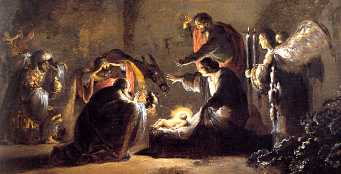
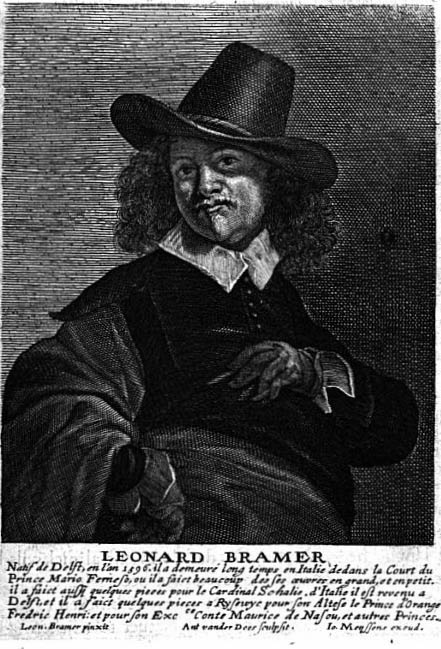 Leonaert
Bramer (1596-1674). History painter, also landscape and portrait.
Italian sojourn 1614 to before 1628, mastering the fresco technique,
under the name Leonardo delle Notti after his darkly lit
subjects. He was supported in Italy by his mecenas Prince Mario
Farnese.
Leonaert
Bramer (1596-1674). History painter, also landscape and portrait.
Italian sojourn 1614 to before 1628, mastering the fresco technique,
under the name Leonardo delle Notti after his darkly lit
subjects. He was supported in Italy by his mecenas Prince Mario
Farnese.
He must have studied Caravaggism in Italy and thus in Delft
he had a head start over Willem van
Vliet and Van Couwenbergh, local
painters with an active interest in Utrecht Carravagist painters.
In the Delft Guild in 1629, repeatedly headman. Among his many
patrons were members of the House of Orange such as Fredrik Hendrik,
and Count Maurice of Nassau. But local burgomasters and aldermen also
bought his paintings in great numbers. He was a many-sided designer,
working for tapestry firms, designing and painting murals and
ceilings, some of which are illusionistic in style, and he crafted
real fresco painting, which is a rare feat north of the Alps.
Sergeant in the Civic Guard; contracted for the upkeep of
paintings in the Doelen (Civic Guards) building. He lived NEXT to
the Wapen van Dantzig (Dantzig Arms) which is nr 48, to the north side, on Koornmarkt,
probably renting it before 1638 and finally bying it in 1643 for 2500
guilders. In 1653 he was contracted to paint a fresco in a corridor
between his house and that of his neighbor, Anthony van Bronchorst on
nr. 50. Bramer also painted frescos, now lost, in the Delft
Prinsenhof and for houses belonging to Frederik Hendrik and
Maurits van Nassau. Between 1660-1668 the Town of Delft ordered
paintings for a total of 2330 guilders.
(The now corrected info about Wapen van Danzig was kindly provided by Hans Slager, 2016.)
The image above shows an detail from The Adoration of the
Shepherds by Bramer.
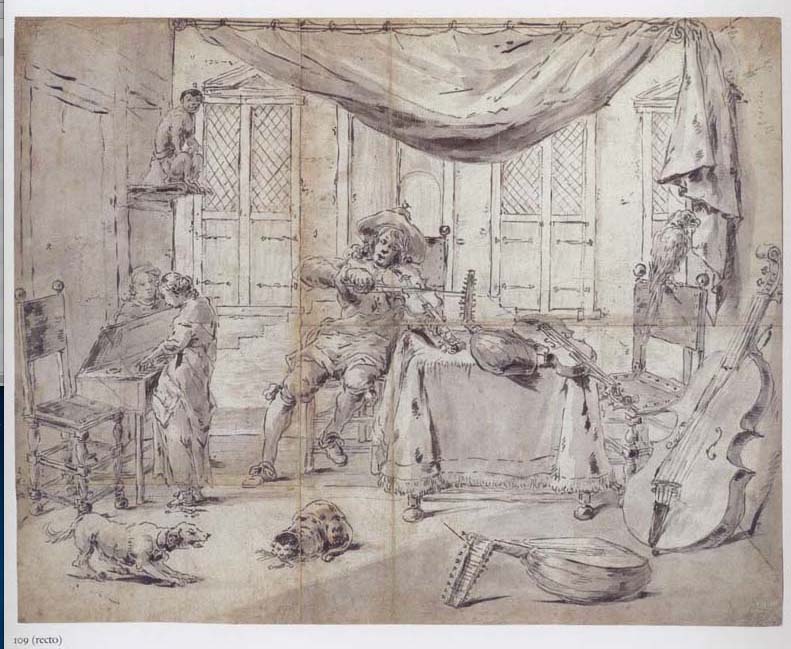
Bramer: A music party.
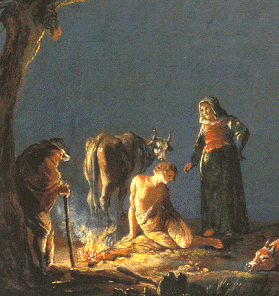 His
famous Album Bramer (drawn between 1642-1654, now in Leiden) contains
many sketches after paintings in Delft collections.
His
famous Album Bramer (drawn between 1642-1654, now in Leiden) contains
many sketches after paintings in Delft collections.
In 1648 he purchased a house on the north side of Pieterstraat for
910 guilders and lived there in 1658 according to one source. Two
adjacent houses on the north side of Pieterstraat were sold in 1668
for 400 guilders. He lived again on Koornmarkt in 1670 and died
there.
Bramer contributed to the interior decoration of the Guild hall.
This is what Van Bleyswijck, Author of History op Delft wrote
in 1667 about the interior of the large upstairs room within this
building in which the Guild members met for official business.
Opposite the open hearth stone mantlepiece (on which the names of
the burgomasters of mayors were engraved) stood the
[painting] of the President of the Guild and the six head
men. The entire wall was covered with stretched linnen on which a
triumphal arch was painted in perspective. Then this quotation:
"On the right hand side of the stone [=hearth ?] a section
with this inscription is placed [a human figure being the
personification of] the 'Art of Painting', holding a panel and
paintbrushes in its hand. On the left hand side is 'Proportion' or
'Even-balance in Architecture', holding a carpenter's square and
compass in its hand, as well as a stonemason's hammer, indicating
'Sculpture'. Under her feet hanging festoons made of various
painters' implements, and next to it are steps to reach the space
under the aforementioned Triumphal arch; under this arch one sees
Mercury and Apollo standing face to face; one also sees two Busts at
the corners of the parapet of the stairs: Zeuxis and Artemisia. All
of this has been painted with love for the guild by Cornelis de Man;
the same way Leonard Bramer has painted the eight wooden ceiling
coffers [? Dutch: welsel] with the Seven Liberal Arts, adding
the Art of Painting in the eighth." [translation by Kees
Kaldenbach]
May have influenced Abraham Pietersz Vromans
and Pieter Pietersz Vromans.
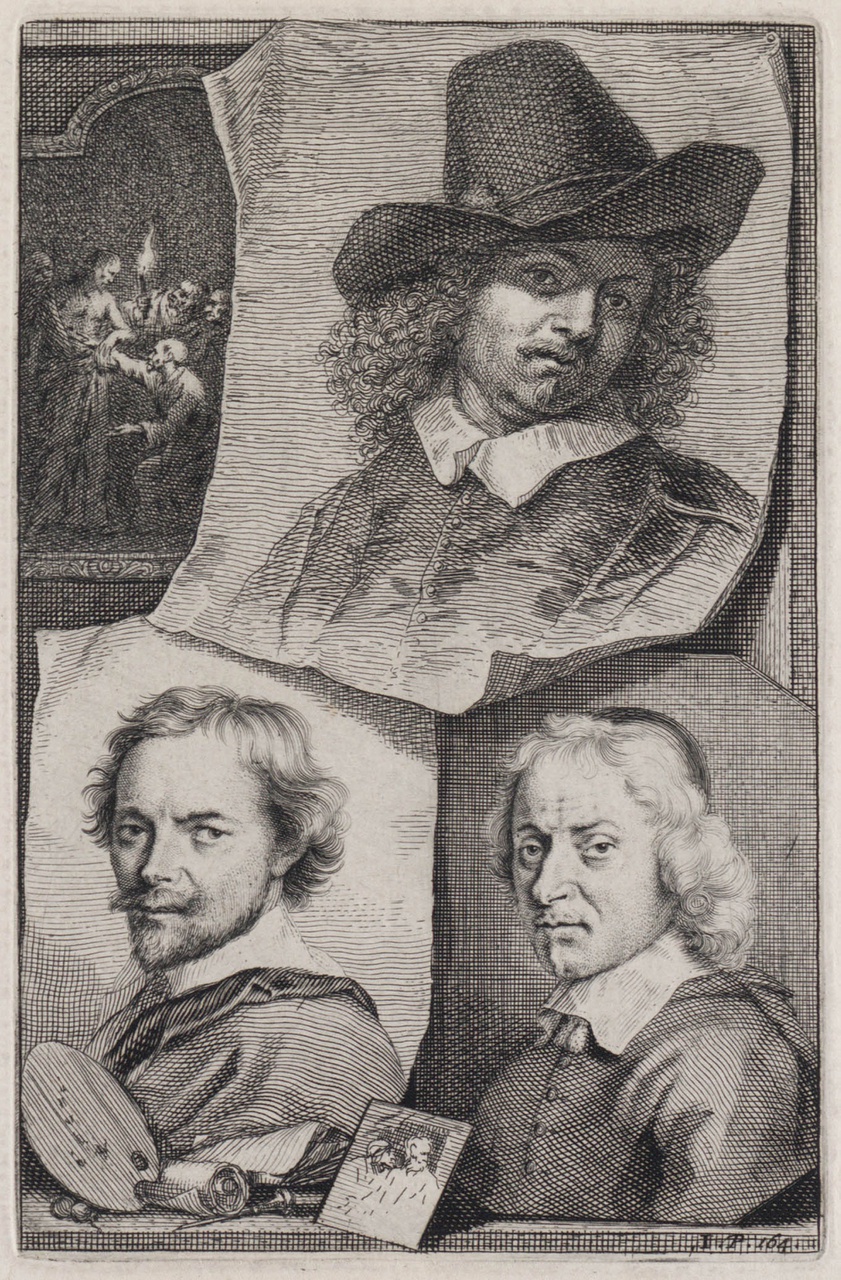
Bramer is depicted here at the bottom left.
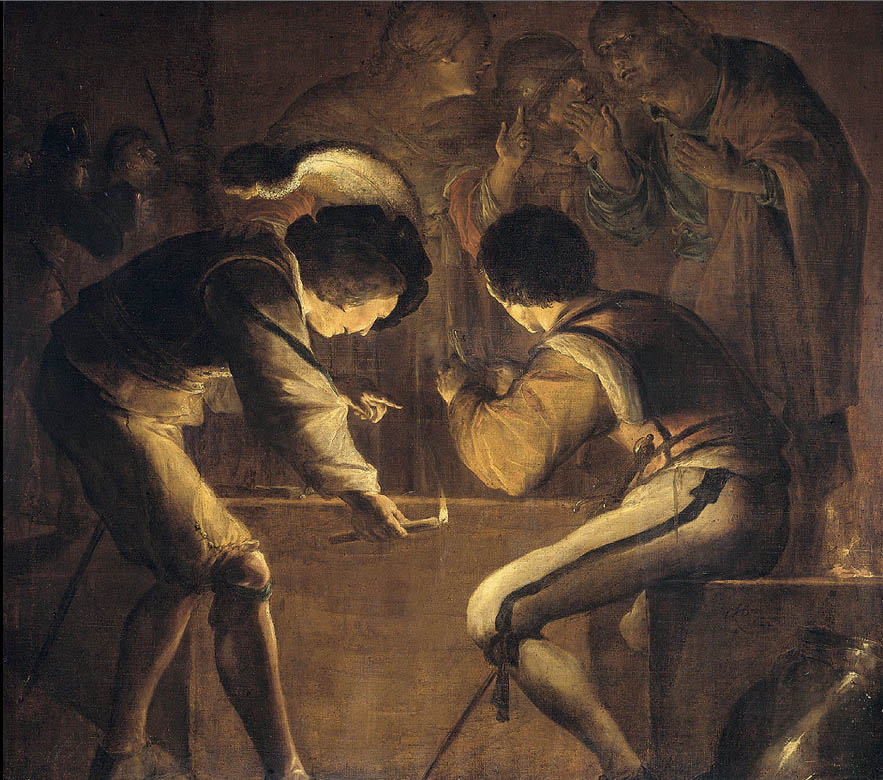
Leonard Bramer Peters Denial, 1642 Rijksmuseum Amsterdam, -legs DesTombe, 1903 the latter also donated Vermeer's Girl with Pearl Earring.
Note. Wichmann 1918, p. 4, 6,7 notes that
fresco technique is very rare in the seventeenth century Republic; he
also mentions Rome travel in 1648. Bramer paid 2500 guilders for the
Danzig Arms on 20 January 1643. Source: (NA 1691, Not. W. de Langue),
also in Ten Brink Goldsmith Bramer (1994) 18 probably based on
Soutendam, Necrologium, p. 26. The word fresco is used in the
Bronchorst contract, RKD Bredius archive, artist folder, quoting doc.
28 Dec. 1653.
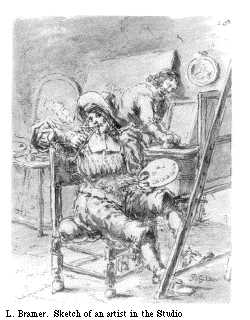 RKD
Bredius archive, artist folder, quoting 1) buying Pieterstraat 1648;
owning it in 1658; selling it with adjacent house 18 Aug. 1668 for
400. Pieterstraat also in RKD Bredius archive, box 'Steden B', fol.
20, quoting 1 April 1649. Bredius also quotes 17 Nov. 1670 as
Koornmarkt, living there with several persons including his sister.
Neighbor to the south Bronchorst; neighbor to the north Louris Buys.
Number 48 and 50 have been pinpointed by combining data from GAD
Beydals files and confirmed by GAD file Koopbrieven huiseigenaren.
2330 guilders mentioned in Montias AA 1982
RKD
Bredius archive, artist folder, quoting 1) buying Pieterstraat 1648;
owning it in 1658; selling it with adjacent house 18 Aug. 1668 for
400. Pieterstraat also in RKD Bredius archive, box 'Steden B', fol.
20, quoting 1 April 1649. Bredius also quotes 17 Nov. 1670 as
Koornmarkt, living there with several persons including his sister.
Neighbor to the south Bronchorst; neighbor to the north Louris Buys.
Number 48 and 50 have been pinpointed by combining data from GAD
Beydals files and confirmed by GAD file Koopbrieven huiseigenaren.
2330 guilders mentioned in Montias AA 1982
In a private communication Montias, 2000,
states that Anthonie Palamedes bought a house next to Bramer's for
900 f. on Coorenmarckt, south side of Burchwal (NA 1691, Not. W. de
Langue), 23 January 1643). However this latter house is hard to pinpoint
as these two streets are close together but do not intersect. Montias
(1993) p. 194 also mentions the Civic Guard.
Arnold Houbraken, De groote Schouburgh
der Nederlantsche Konstschilders en Schilderessen, The Hague 1752
[2nd ed.] Book 1, page 164.
Below is a funny drawing of a much interested persons, looking through a peep hole in a door,
a source of great public attention.
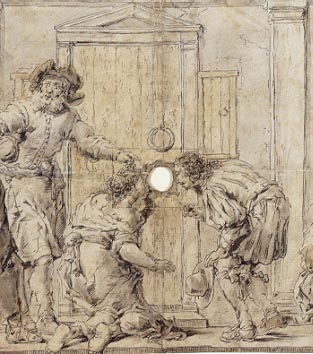
This page forms part of a large encyclopedic site on Delft. Research by Drs. Kees Kaldenbach (email). A
full presentation is on view at johannesvermeer.info.
Launched 16 February 2001; Last update March 1, 2017.

 Leonaert
Bramer (1596-1674). History painter, also landscape and portrait.
Italian sojourn 1614 to before 1628, mastering the fresco technique,
under the name Leonardo delle Notti after his darkly lit
subjects. He was supported in Italy by his mecenas Prince Mario
Farnese.
Leonaert
Bramer (1596-1674). History painter, also landscape and portrait.
Italian sojourn 1614 to before 1628, mastering the fresco technique,
under the name Leonardo delle Notti after his darkly lit
subjects. He was supported in Italy by his mecenas Prince Mario
Farnese.
 His
famous Album Bramer (drawn between 1642-1654, now in Leiden) contains
many sketches after paintings in Delft collections.
His
famous Album Bramer (drawn between 1642-1654, now in Leiden) contains
many sketches after paintings in Delft collections.

 RKD
Bredius archive, artist folder, quoting 1) buying Pieterstraat 1648;
owning it in 1658; selling it with adjacent house 18 Aug. 1668 for
400. Pieterstraat also in RKD Bredius archive, box 'Steden B', fol.
20, quoting 1 April 1649. Bredius also quotes 17 Nov. 1670 as
Koornmarkt, living there with several persons including his sister.
Neighbor to the south Bronchorst; neighbor to the north Louris Buys.
Number 48 and 50 have been pinpointed by combining data from GAD
Beydals files and confirmed by GAD file Koopbrieven huiseigenaren.
2330 guilders mentioned in Montias AA 1982
RKD
Bredius archive, artist folder, quoting 1) buying Pieterstraat 1648;
owning it in 1658; selling it with adjacent house 18 Aug. 1668 for
400. Pieterstraat also in RKD Bredius archive, box 'Steden B', fol.
20, quoting 1 April 1649. Bredius also quotes 17 Nov. 1670 as
Koornmarkt, living there with several persons including his sister.
Neighbor to the south Bronchorst; neighbor to the north Louris Buys.
Number 48 and 50 have been pinpointed by combining data from GAD
Beydals files and confirmed by GAD file Koopbrieven huiseigenaren.
2330 guilders mentioned in Montias AA 1982